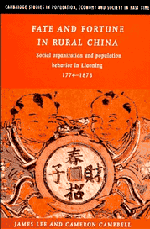Book contents
- Frontmatter
- Contents
- List of figures
- List of maps
- List of tables
- Acknowledgements
- PART 1 DAOYI VILLAGE
- PART 2 THE LIAONING DEMOGRAPHIC SYSTEM
- PART 3 HOUSEHOLD ORGANIZATION AND POPULATION BEHAVIOR
- PART 4 BANNER ORGANIZATION AND POPULATION BEHAVIOR
- EPILOGUE: PROSPECTS, IMPLICATIONS, AND COMPARISONS
- Appendices
- Glossary
- References
- Index
- Cambridge Studies in Population, Economy and Society in Past Time
PART 4 - BANNER ORGANIZATION AND POPULATION BEHAVIOR
Published online by Cambridge University Press: 20 October 2009
- Frontmatter
- Contents
- List of figures
- List of maps
- List of tables
- Acknowledgements
- PART 1 DAOYI VILLAGE
- PART 2 THE LIAONING DEMOGRAPHIC SYSTEM
- PART 3 HOUSEHOLD ORGANIZATION AND POPULATION BEHAVIOR
- PART 4 BANNER ORGANIZATION AND POPULATION BEHAVIOR
- EPILOGUE: PROSPECTS, IMPLICATIONS, AND COMPARISONS
- Appendices
- Glossary
- References
- Index
- Cambridge Studies in Population, Economy and Society in Past Time
Summary
While the household in rural Liaoning was largely a private institution, the banner system was an entirely public institution. Created by the Qing state in the early-mid seventeenth century, banner ranks delineated the framework of social organization above the household. Households were organized into lineage units called zu patterned after the Manchu mukūn. These lineage organizations functioned as units of civil, fiscal, judicial, and military administration and provided the lowest level of formal government in Liaoning.
In contrast with Han civil society, however, the banner system did not restrict itself to affairs above the household level. Instead the banner system penetrated household organization down to the level of individual adult males called ding. Daoyi district was state land, and its people were not just state servants, but elite military servants. Every adult male in the area was therefore liable for military service as well as for a variety of local civil service positions. The Eight Banner registers that provide the bulk of our data accordingly record for each ding, detailed information on his obligation or ability to serve the state, as well as any specific occupational or organizational banner positions he might hold.
The banner system, therefore, provided many opportunities for individual advancement outside the household. We distinguish in Part Four between two overlapping banner hierarchies: the organizational and the occupational. On the one hand, men could rise to a position of leadership within the banner lineage organizations. On the other hand, men could also ascend to a number of formal artisanal, civil, and military occupations. In either case, just as demographic opportunities varied by position in the domestic hierarchy, so they also varied by position in these banner hierarchies.
- Type
- Chapter
- Information
- Fate and Fortune in Rural ChinaSocial Organization and Population Behavior in Liaoning 1774–1873, pp. 157 - 158Publisher: Cambridge University PressPrint publication year: 1997

